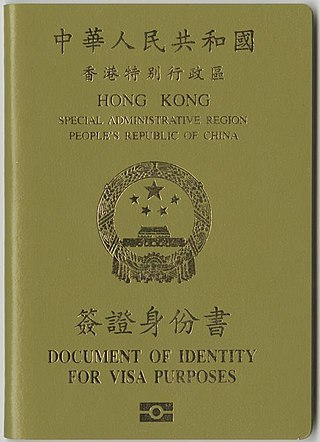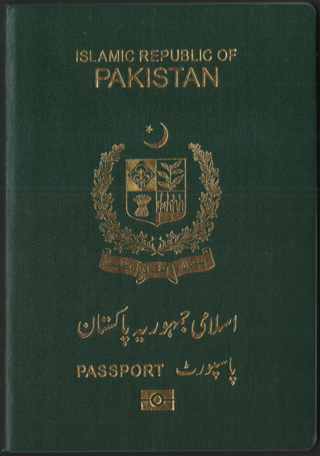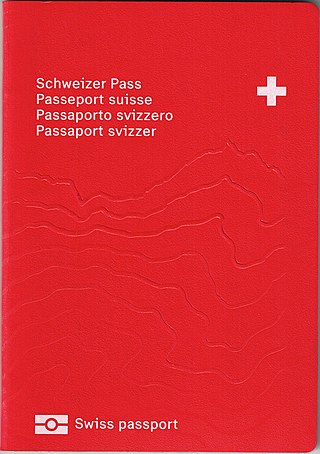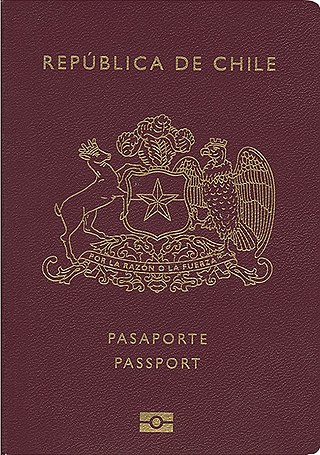An identity document is any document that may be used to prove a person's identity. If issued in a small, standard credit card size form, it is usually called an identity card, or passport card. Some countries issue formal identity documents, as national identification cards that may be compulsory or non-compulsory, while others may require identity verification using regional identification or informal documents. When the identity document incorporates a person's photograph, it may be called photo ID.

The Hong Kong Special Administrative Region passport is a passport issued only to permanent residents of Hong Kong who also hold Chinese citizenship. In accordance with the Basic Law of the Hong Kong Special Administrative Region, since the handover in 1997, the passport has been issued by the Immigration Department of the Government of Hong Kong under the authorisation of the Central People's Government of the People's Republic of China. As the official languages of Hong Kong are Chinese and English, the passport is printed bilingually in both Chinese and English. In addition, unlike Chinese passport which can be issued by Chinese diplomatic missions abroad, the Immigration Department of Hong Kong is the only issuing authority for HKSAR passports.

An Irish passport is the passport issued to citizens of Ireland. An Irish passport enables the bearer to travel internationally and serves as evidence of Irish nationality and citizenship of the European Union. It also facilitates the access to consular assistance from both Irish embassies and any embassy from other European Union member states while abroad.

The Hong Kong Special Administrative Region Document of Identity for Visa Purposes is a biometric travel document issued by the Hong Kong Immigration Department to residents of Hong Kong who are unable to obtain a national passport. It is usually valid for seven years.

A travel document is an identity document issued by a government or international entity pursuant to international agreements to enable individuals to clear border control measures. Travel documents usually assure other governments that the bearer may return to the issuing country, and are often issued in booklet form to allow other governments to place visas as well as entry and exit stamps into them.

Thai passport is the passport issued to citizens and nationals of Thailand by the Passport Division of the Department of Consular Affairs within the Ministry of Foreign Affairs. Thai biometric passports have been issued since August 2005.

The Ukrainian passport is a document issued for nationals of Ukraine as proof of Ukrainian citizenship. The country issues international passports that are used for travel abroad. Until 2016, citizens were issued a soft booklet internal passport as their primary domestic identification document; the booklets were replaced by an identity card with existing passports remaining valid. Electronic passports are available to citizens through the government smartphone application Diia.

The Colombian passport is a travel document which is issued to citizens of Colombia for the purpose of international travel. Since September 2015, a biometric passport has been issued, but the previously issued machine-readable passport can be used until its expiration date.

Lithuanian passport is an official document, issued to Lithuanian citizens to identify themselves as such and/or to facilitate travel outside Lithuania. Every Lithuanian citizen is also a citizen of the European Union. The Lithuanian passport, along with the national identity card allows for free rights of movement and residence in any of the states of the European Union, European Economic Area and Switzerland.

The Pakistani passport is an essential travel document granted by the Government of Pakistan to its citizens for international travel purposes. The Directorate General of Immigration & Passports holds the responsibility for passport issuance, under the regulation of the Ministry of Interior.

A Swiss passport is the passport issued to citizens of Switzerland to facilitate international travel. Beside serving as proof of Swiss citizenship, they facilitate the process of securing assistance from Swiss consular officials abroad.

A Chilean passport is an identity document issued to citizens of Chile to facilitate international travel. Chilean passports are valid for worldwide travel and facilitate the access to consular services whilst abroad. They are issued by the Registro Civil e Identificación.

The European Union itself does not issue ordinary passports, but ordinary passport booklets issued by its 27 member states share a common format. This common format features a colored cover emblazoned—in the official language(s) of the issuing country —with the title "European Union", followed by the name(s) of the member state, the heraldic "Arms" of the State concerned, the word "PASSPORT", together with the biometric passport symbol at the bottom center of the front cover.

A United Nations laissez-passer is a diplomatic travel document issued by the United Nations under the provisions of Article VII of the 1946 Convention on the Privileges and Immunities of the United Nations in its offices in New York City and Geneva, as well as by the International Labour Organization (ILO).

The Algerian passport is an international travel document issued to citizens of Algeria, and may also serve as proof of Algerian citizenship. Besides enabling the bearer to travel internationally and serving as indication of Algerian citizenship, the passport facilitates the process of securing assistance from Algerian consular officials abroad.

The Lebanese passport is a passport issued to the citizens of the Republic of Lebanon to enable them to travel outside the Republic of Lebanon and entitles the bearer to the protection from the diplomatic missions and consulates of the Republic of Lebanon if necessary. It is issued exclusively by the Lebanese Directorate General of General Security (DGGS), and can also be issued at various Lebanese diplomatic missions and/or consulates outside the Republic of Lebanon. It allows the bearer a freedom of living in the Republic of Lebanon without any immigration requirements, participate in the Lebanese political system, entry to and exit from the Republic of Lebanon through any port, travel to and from other countries in accordance with visa requirements, facilitates the process of securing consular assistance abroad from the diplomatic missions and consulates of the Republic of Lebanon if necessary, and requests protection for the bearer while abroad.

Maldivian passport is a proof of citizenship, issued by Maldives Immigration, to all the nationals of the Maldives for international travel. The current passport, the 2nd generation e-passport, was launched on 24 January 2016. This passport consists of a highly secured poly-carbonate data page with laser engraved photo and data. Each visa page of the passport has a different design, represented with numerous illustrations by the Maldivian local artist, Hussain Ali Manik. A Maldivian Passport can be issued to any Maldivian citizen who applies for a passport.

The German Identity Card is issued to German citizens by local registration offices in Germany and diplomatic missions abroad, while it is produced at the Bundesdruckerei in Berlin.
The EDAPS Consortium was formed in Kyiv in 2004 by eight Ukrainian security printing and information technology companies. Its primary operations included manufactured identification documents and information systems.
ZNAK Ltd. – is a Ukrainian manufacturer of plastic payment cards, document application forms and polycarbonate pages for passports, etc. Located in Kyiv. A member of the Ukrainian EDAPS Consortium.



















